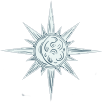Chinese Astrology is a traditional system of divination that originated in ancient China and is based on the lunar calendar, incorporating elements of philosophy, astronomy, and mythology.
Unlike Western astrology, which focuses on zodiac signs based on the Sun's position, Chinese astrology is structured around 12 animal signs, five elements, and a 60-year cycle.
Key Components of Chinese Astrology
1. The 12 Animal Signs
Each year in the Chinese zodiac cycle is represented by an animal, which influences the personality and destiny of people born in that year. The 12 animals are:
o Rat: Clever, resourceful, quick-witted
o Ox: Hardworking, reliable, determined
o Tiger: Brave, competitive, confident
o Rabbit: Gentle, elegant, compassionate
o Dragon: Ambitious, charismatic, energetic
o Snake: Wise, intuitive, strategic
o Horse: Independent, enthusiastic, dynamic
o Goat (Sheep): Calm, creative, empathetic
o Monkey: Playful, curious, intelligent
o Rooster: Observant, hardworking, courageous
o Dog: Loyal, honest, dependable
o Pig (Boar): Generous, kind, diligent
Each animal repeats every 12 years, and the traits of the sign influence both individuals and the year itself.
2. Five Elements (Wu Xing)
The five elements—Wood, Fire, Earth, Metal, and Water—are combined with the zodiac animals to create a 60-year cycle. Each element lasts for two consecutive years and adds unique characteristics to the animal sign for that year:
o Wood: Growth, creativity, cooperation
o Fire: Passion, energy, transformation
o Earth: Stability, reliability, grounding
o Metal: Strength, determination, focus
o Water: Flexibility, intuition, adaptability
3. Yin and Yang
The principle of Yin (feminine, passive, dark) and Yang (masculine, active, bright) is also crucial. Each animal sign is associated with either Yin or Yang energy, which affects its expression and compatibility with others.
The Chinese Zodiac Calendar
The Chinese New Year, which falls between late January and mid-February, marks the start of the zodiac year. For example:
• 2023: Year of the Water Rabbit
• 2024: Year of the Wood Dragon
Chinese Astrology Chart (Ba Zi or Four Pillars of Destiny)
In addition to the animal sign of the birth year, Chinese astrology considers the influences of:
• The Year (outer personality and general traits)
• The Month (inner self and career)
• The Day (core personality and relationships)
• The Hour (future potential and children).
Each of these pillars is determined by the interplay of the animal sign and element.
Compatibility in Chinese Astrology
• Chinese astrology emphasizes compatibility between signs for relationships and partnerships.
• Signs are traditionally grouped into trines (compatible groups of three):
o Rat, Dragon, Monkey
o Ox, Snake, Rooster
o Tiger, Horse, Dog
o Rabbit, Goat, Pig
For instance, a Rat is highly compatible with a Dragon or a Monkey, but less so with a Horse.
Chinese Astrology vs. Western Astrology
• Structure: Western astrology focuses on Sun signs and a 12-month solar calendar, while Chinese astrology is based on the lunar calendar and 12-year animal cycle.
• Elements: Western astrology uses four elements (Earth, Air, Fire, Water), while Chinese astrology uses five (Wood, Fire, Earth, Metal, Water).
• Interpretation: Chinese astrology emphasizes broader life patterns, community, and harmony with nature, whereas Western astrology often focuses more on individuality and psychology.
Modern Applications
Chinese astrology is widely used to:
1. Determine personality traits and compatibility in relationships.
2. Choose auspicious dates for important events (weddings, business openings, etc.).
3. Gain insight into career and financial decisions.
4. Understand annual influences based on the year’s animal and element.
If you’d like to learn about your Chinese zodiac sign, compatibility, or predictions for a specific year, feel free to ask!

